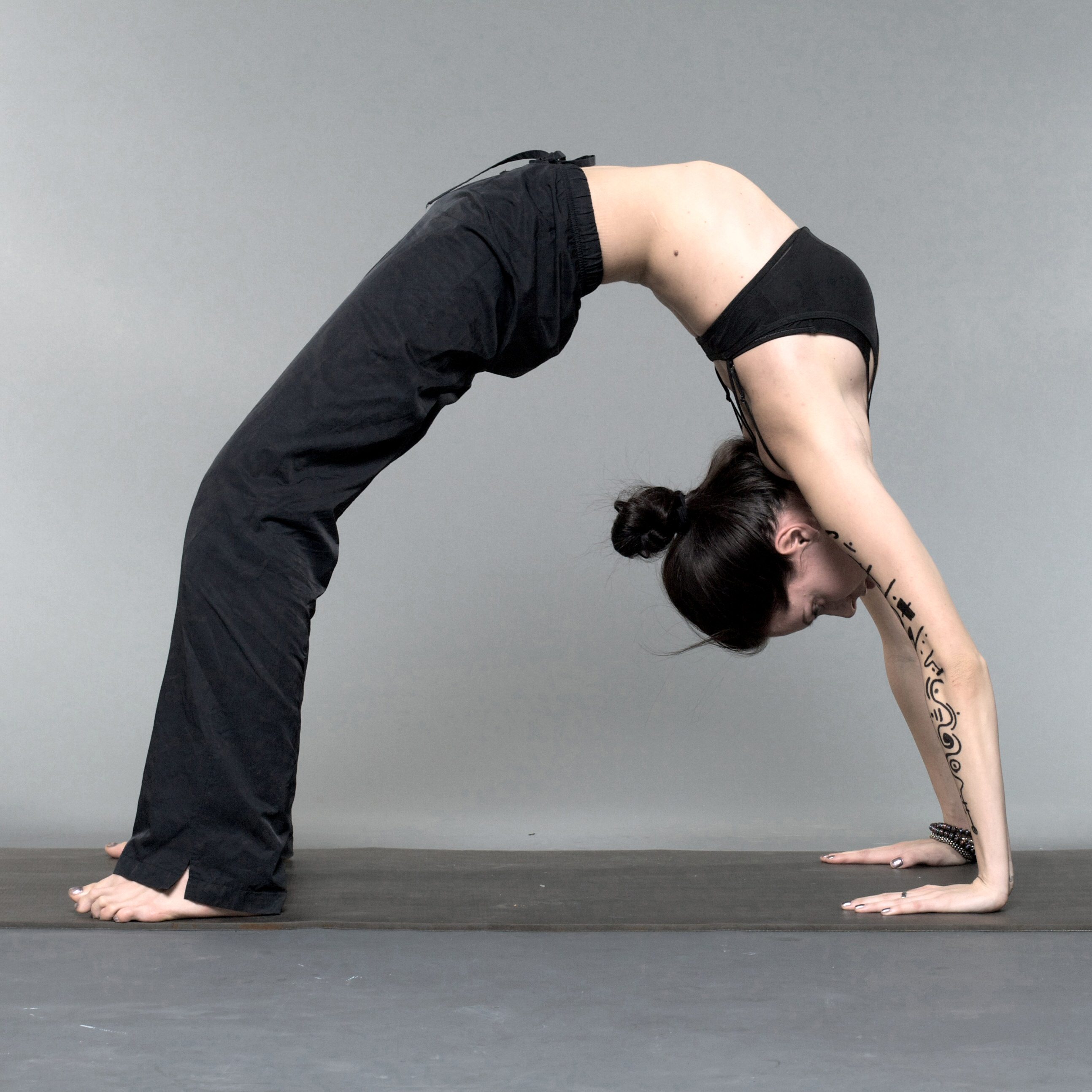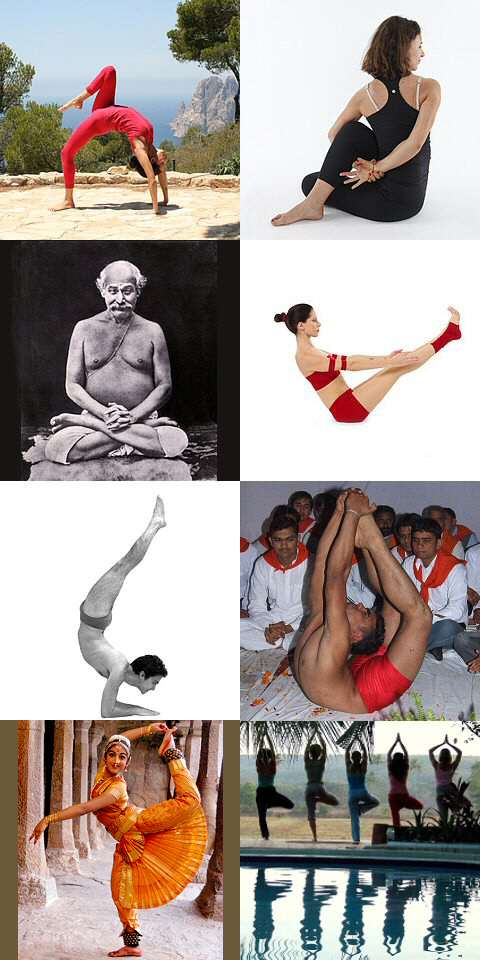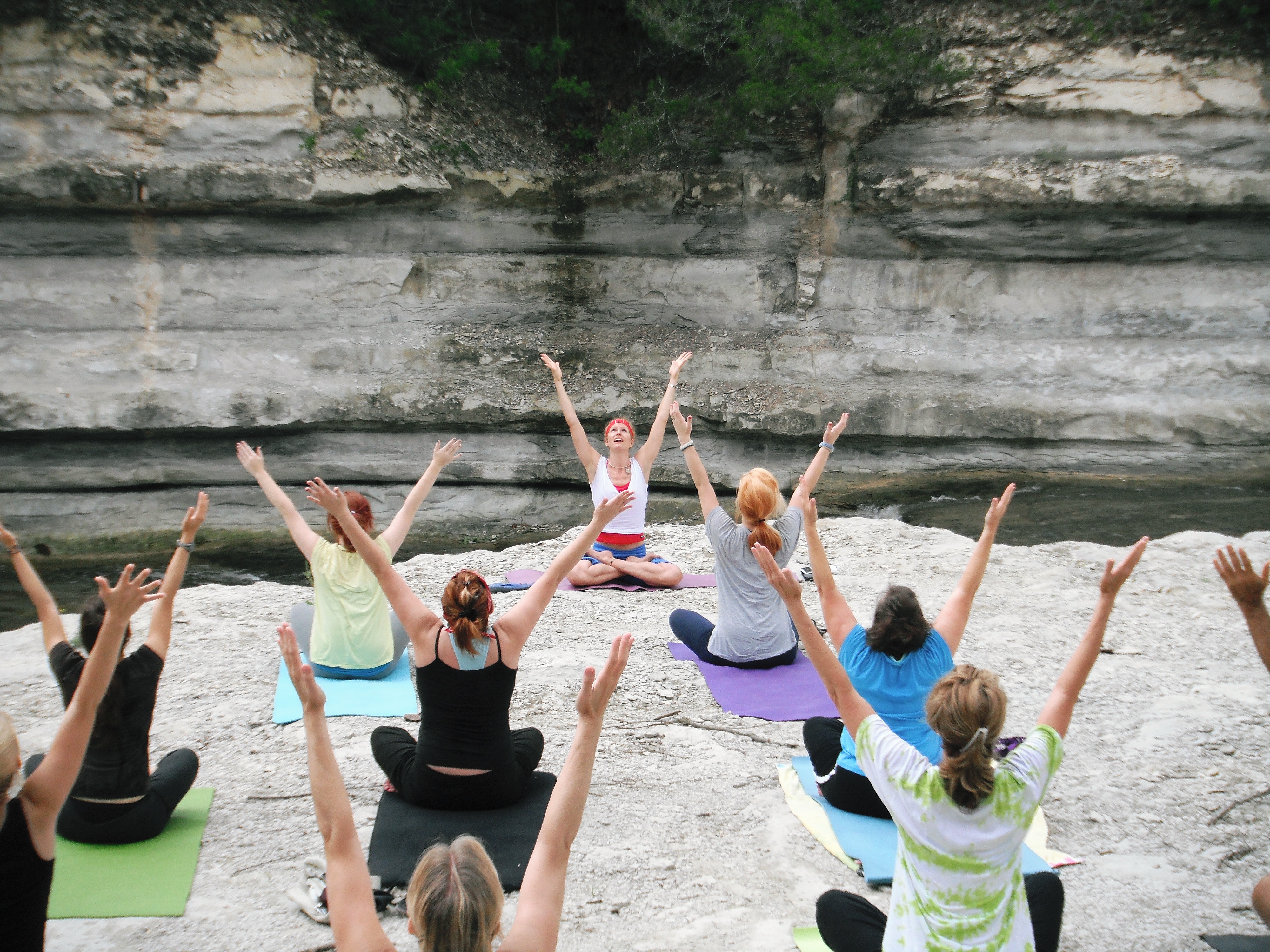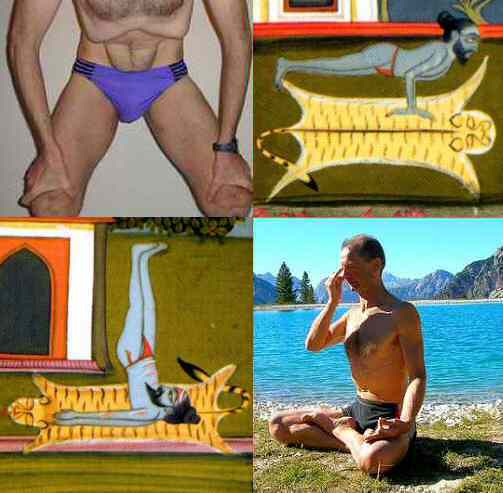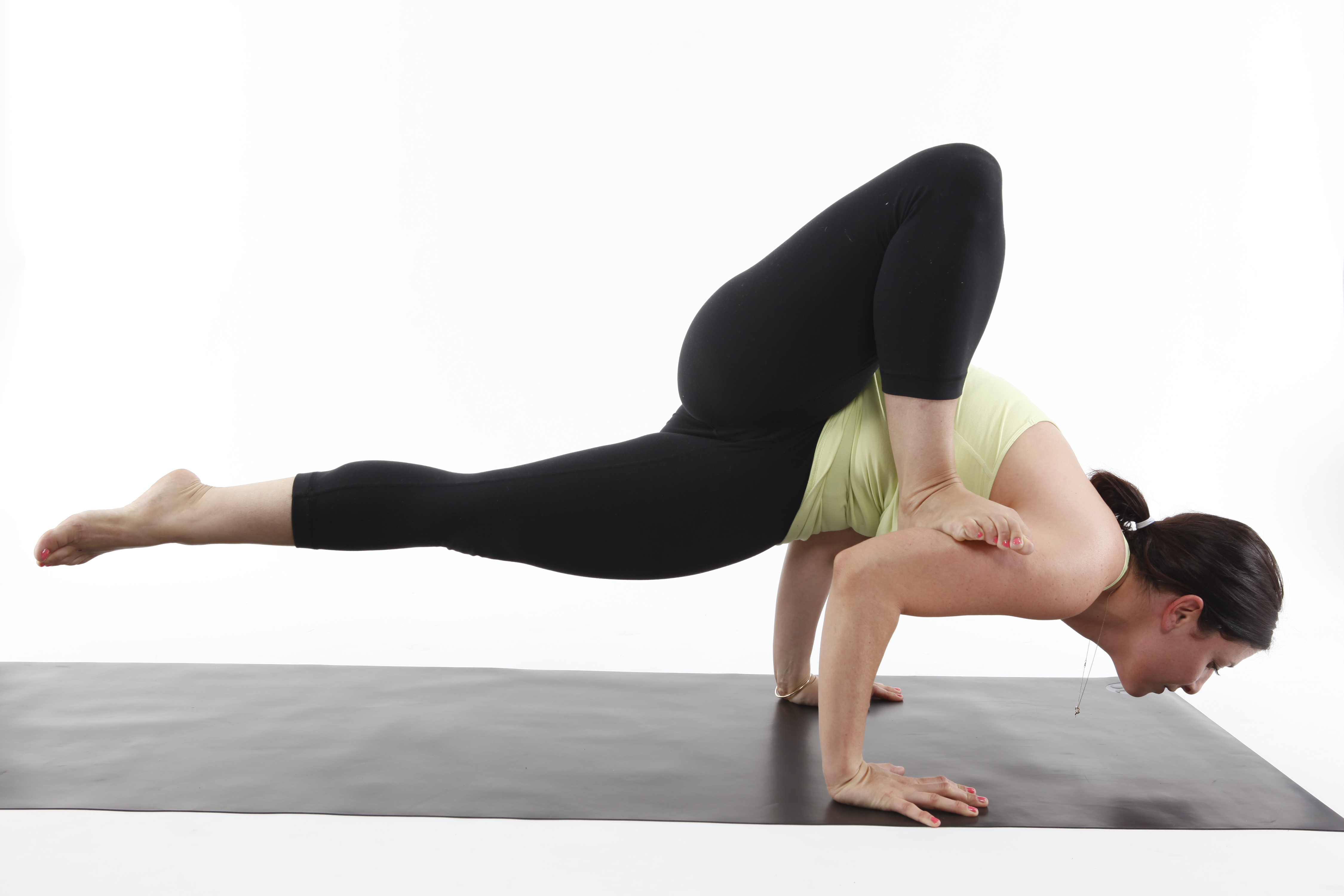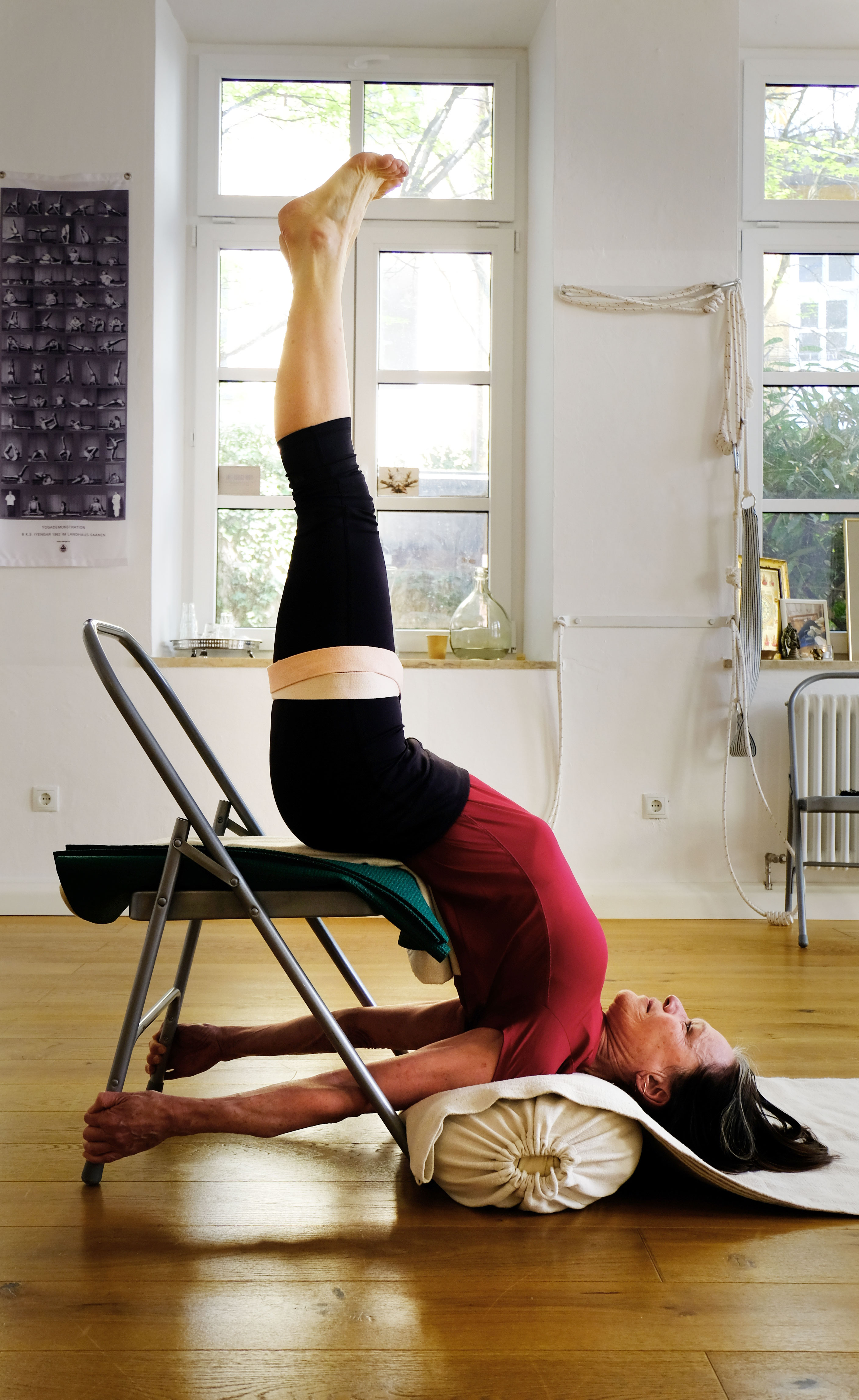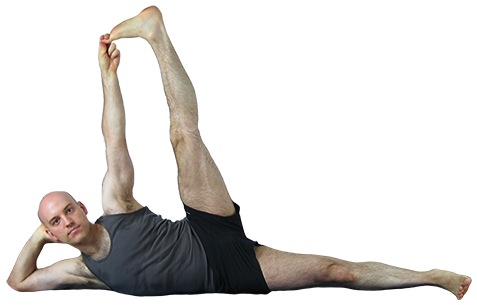|
Camatkarasana
Utthita Vasisthasana (sometimes shortened to Vasisthasana) () or Side Plank pose is a balancing asana in modern yoga as exercise. Etymology and origins The name of the pose comes from the Sanskrit extended, Vasiṣṭha, a sage, and , "posture" or "seat". The pose is not described in the medieval hatha yoga texts. It appears in the 20th century in the Ashtanga (vinyasa) yoga of Pattabhi Jois. Description The pose is a balancing posture with the body, both legs, and both arms straight, the body on one side. The upper arm is raised as high as possible. The upper leg may be rested on the lower leg, or for the full pose (sometimes called Eka Pada Vasisthasana, One-legged Side Plank) may be raised as high as possible; the upper hand may grasp the foot (sometimes called Vasisthasana B), and the gaze may be directed to the upper hand. Variations Chamatkarasana (from Sanskrit , miracle) or Wild Thing Pose keeps most of the body's weight on one foot and the hand on the same ... [...More Info...] [...Related Items...] OR: [Wikipedia] [Google] [Baidu] |
Chakrasana
Chakrasana () or Urdhva Dhanurasana () is a backbending asana in yoga as exercise. The one-legged variant is often chosen by yoga practitioners who wish to advertise themselves. Etymology and origins The name Chakrasana comes from the Sanskrit words ''chakra'', "wheel", and , "posture" or "seat". The name Urdhva Dhanurasana comes from the Sanskrit , upwards, and , a bow (for shooting arrows). The pose is illustrated in the 19th century ''Sritattvanidhi'' as ''Paryaṇkāsana'', Couch Pose. Description In the general form of the asana, the practitioner has hands and feet on the floor, and the abdomen arches up toward the sky. It may be entered from a supine position or through a less rigorous supine backbend, such as Setu Bandha Sarvangasana (Bridge Pose). Some advanced practitioners can move into Wheel Pose by "dropping back" from Tadasana (Mountain Pose), or by standing with the back to a wall, reaching arms overhead and walking hands down the wall toward the floor. Adva ... [...More Info...] [...Related Items...] OR: [Wikipedia] [Google] [Baidu] |
Yoga PLank
Yoga (UK: , US: ; 'yoga' ; ) is a group of physical, mental, and spiritual practices or disciplines that originated with its own philosophy in ancient India, aimed at controlling body and mind to attain various salvation goals, as practiced in the Hindu, Jain, and Buddhist traditions. Yoga may have pre-Vedic origins, but is first attested in the early first millennium BCE. It developed as various traditions in the eastern Ganges basin drew from a common body of practices, including Vedic elements. Yoga-like practices are mentioned in the ''Rigveda'' and a number of early Upanishads, but systematic yoga concepts emerge during the fifth and sixth centuries BCE in ancient India's ascetic and Śramaṇa movements, including Jainism and Buddhism. The ''Yoga Sutras of Patanjali'', the classical text on Hindu yoga, samkhya-based but influenced by Buddhism, dates to the early centuries of the Common Era. Hatha yoga texts began to emerge between the ninth and 11th centuries, o ... [...More Info...] [...Related Items...] OR: [Wikipedia] [Google] [Baidu] |
Asana
An āsana (Sanskrit: आसन) is a body posture, originally and still a general term for a sitting meditation pose,Verse 46, chapter II, "Patanjali Yoga sutras" by Swami Prabhavananda, published by the Sri Ramakrishna Math p. 111 and later extended in hatha yoga and modern yoga as exercise, to any type of position, adding reclining, standing, inverted, twisting, and balancing poses. The ''Yoga Sutras of Patanjali'' define "asana" as " position thatis steady and comfortable". Patanjali mentions the ability to sit for extended periods as one of the eight limbs of his system. Patanjali '' Yoga sutras'', Book II:29, 46 Asanas are also called yoga poses or yoga postures in English. The 10th or 11th century '' Goraksha Sataka'' and the 15th century '' Hatha Yoga Pradipika'' identify 84 asanas; the 17th century '' Hatha Ratnavali'' provides a different list of 84 asanas, describing some of them. In the 20th century, Indian nationalism favoured physical culture in response t ... [...More Info...] [...Related Items...] OR: [Wikipedia] [Google] [Baidu] |
Yoga As Exercise
Yoga as exercise is a physical activity consisting mainly of asana, postures, often connected by vinyasa, flowing sequences, sometimes accompanied by pranayama, breathing exercises, and frequently ending with savasana, relaxation lying down or meditation. Yoga in this form has become familiar across the world, especially Yoga in the United States, in the US and Europe. It is derived from medieval Haṭha yoga, which made use of similar postures, but it is generally simply called "yoga". Academic research has given yoga as exercise a variety of names, including modern postural yoga and transnational anglophone yoga. Postures were not central in any of the older traditions of yoga; posture practice was revived in the 1920s by yoga gurus including Yogendra and Kuvalayananda, who emphasised its health benefits. The flowing sequences of Surya Namaskar (Salute to the Sun) were pioneered by the Rajah of Aundh State, Aundh, Bhawanrao Shrinivasrao Pant Pratinidhi, in the 1920s. It and ma ... [...More Info...] [...Related Items...] OR: [Wikipedia] [Google] [Baidu] |
Sanskrit
Sanskrit (; stem form ; nominal singular , ,) is a classical language belonging to the Indo-Aryan languages, Indo-Aryan branch of the Indo-European languages. It arose in northwest South Asia after its predecessor languages had Trans-cultural diffusion, diffused there from the northwest in the late Bronze Age#South Asia, Bronze Age. Sanskrit is the sacred language of Hinduism, the language of classical Hindu philosophy, and of historical texts of Buddhism and Jainism. It was a lingua franca, link language in ancient and medieval South Asia, and upon transmission of Hindu and Buddhist culture to Southeast Asia, East Asia and Central Asia in the early medieval era, it became a language of religion and high culture, and of the political elites in some of these regions. As a result, Sanskrit had a lasting effect on the languages of South Asia, Southeast Asia and East Asia, especially in their formal and learned vocabularies. Sanskrit generally connotes several Indo-Aryan languages# ... [...More Info...] [...Related Items...] OR: [Wikipedia] [Google] [Baidu] |
Vasiṣṭha
Vasishtha (, ) is one of the oldest and revered Vedic rishis or sages, and one of the Saptarishis (seven great Rishis). Vasishtha is credited as the chief author of Mandala 7 of the ''Rigveda''. Vasishtha and his family are mentioned in Rigvedic verse 10.167.4, other Rigvedic mandalas and in many Vedic texts. His ideas have been influential and he was called the first sage of the Vedanta school of Hindu philosophy by Adi Shankara. The ''Yoga Vasistha, Yoga Vasishtha'', ''Vasishtha Samhita'', as well as some versions of the ''Agni Purana'' and ''Vishnu Purana'' are attributed to him. He is the subject of many stories, such as him being in possession of the divine cow Kamadhenu and Nandini her child, who could grant anything to their owners. He is famous in Hindu stories for his legendary conflicts with sage Vishvamitra. In the Ramayana, he was the family priest of the Raghu dynasty and teacher of Rama and his brothers. Etymology Vasishtha is also spelled as ' and is Sanskrit fo ... [...More Info...] [...Related Items...] OR: [Wikipedia] [Google] [Baidu] |
Hatha Yoga
Hatha yoga (; Sanskrit हठयोग, International Alphabet of Sanskrit Transliteration, IAST: ''haṭhayoga'') is a branch of yoga that uses physical techniques to try to preserve and channel vital force or energy. The Sanskrit word हठ ''haṭha'' literally means "force", alluding to a system of physical techniques. Some hatha yoga style techniques can be traced back at least to the 1st-century CE, in texts such as the Hindu Itihasa, Sanskrit epics and Buddhism's Pali canon. The oldest dated text so far found to describe hatha yoga, the 11th-century ''Amritasiddhi, Amṛtasiddhi'', comes from a Tantra, tantric Buddhist milieu. The oldest texts to use the terminology of ''hatha'' are also Vajrayana Buddhist. Hindu hatha yoga texts appear from the 11th century onward. Some of the early hatha yoga texts (11th-13th c.) describe methods to raise and conserve bindu (vital force, that is, semen, and in women ''rajas –'' menstrual fluid). This was seen as the physical esse ... [...More Info...] [...Related Items...] OR: [Wikipedia] [Google] [Baidu] |
Ashtanga (vinyasa) Yoga
Ashtanga yoga (not to be confused with Patanjali's ''Ashtanga (eight limbs of yoga), aṣṭāṅgayoga'', the eight limbs of yoga) is a style of yoga as exercise popularised by K. Pattabhi Jois during the twentieth century, often promoted as a dynamic form of medieval hatha yoga. Jois claimed to have learnt the system from his teacher Tirumalai Krishnamacharya. The style is energetic, synchronising breath with movements. The individual poses (asanas) are linked by flowing movements called vinyasas. Jois established his Ashtanga Yoga Research Institute in 1948. The current style of teaching is called "Mysore style", after the city in India where the practice was originally taught. Ashtanga yoga has given rise to various spinoff styles of Power Yoga, power yoga. Approach Traditionally, Ashtanga yoga students memorised a sequence of asanas and practised it together without being led by a teacher. Teacher-led classes were introduced in K. Pattabhi Jois's later years. Such classes ... [...More Info...] [...Related Items...] OR: [Wikipedia] [Google] [Baidu] |
Pattabhi Jois
K. Pattabhi Jois (26 July 1915 – 18 May 2009) was an Indian Modern yoga gurus, yoga guru who developed and popularized the vinyasa, flowing style of yoga as exercise known as Ashtanga (vinyasa) yoga. In 1948, Jois established the Ashtanga Yoga Research Institute in Mysore, India. Pattabhi Jois is one of a short list of Indians instrumental in establishing modern yoga as exercise in the 20th century, along with B. K. S. Iyengar, another pupil of Krishnamacharya in Mysore. Jois sexual abuse by yoga gurus, sexually abused some of his yoga students by touching inappropriately during adjustments. Sharath Jois has publicly apologised for his grandfather's "improper adjustments". Biography Early life Krishna Pattabhi Jois was born in a Kannada Hindu family on 26 July 1915 (''Guru Purnima, Guru Pūrṇimā'', full moon day) in the village of Kowshika, near Hassan district, Hassan, Karnataka, South India. Jois's father was an Hindu astrology, astrologer, priest, and landholder. His ... [...More Info...] [...Related Items...] OR: [Wikipedia] [Google] [Baidu] |
Yoga Journal
''Yoga Journal'' is a website and digital journal, formerly a print magazine, on yoga as exercise founded in California in 1975 with the goal of combining the essence of traditional yoga with scientific understanding. It has produced live events and materials such as DVDs on yoga and related subjects. The magazine grew from the California Yoga Teachers Association's newsletter, which was called ''The Word''. ''Yoga Journal'' has repeatedly won Western Publications Association's Maggie Awards for "Best Health and Fitness Magazine". It has however been criticized for representing yoga as being intended for affluent white women; in 2019 it attempted to remedy this by choosing a wider variety of yoga models. The magazine was acquired by Outside in 2020. Beginnings ''Yoga Journal'' was started in May 1975 by the California Yoga Teachers Association (CYTA), with Rama Jyoti Vernon as President, William Staniger as the founding editor, and Judith Lasater on the board and serving as ... [...More Info...] [...Related Items...] OR: [Wikipedia] [Google] [Baidu] |
Yoga Using Props
Props used in yoga include chairs, Yoga brick, blocks, belts, Yoga mat, mats, blankets, bolsters, and straps. They are used in Yoga as exercise, postural yoga to assist with correct alignment in an asana, for ease in mindful yoga practice, to enable poses to be held for longer periods in Yin Yoga, where support may allow muscles to relax, and to enable people with movement restricted for any reason, such as stiffness, injury, or arthritis, to continue with their practice. One prop, the yoga strap, has an ancient history, being depicted in temple sculptures and described in manuscripts from ancient and medieval times; it was used in ''Sopasrayasana'', also called ''Yogapattasana'', a seated Meditation posture, meditation pose with the legs crossed and supported by the strap. In modern times, the use of props is associated especially with the yoga guru B. K. S. Iyengar; his disciplined style required props including belts, blocks, and ropes. History The ''yogapaṭṭa'' in sc ... [...More Info...] [...Related Items...] OR: [Wikipedia] [Google] [Baidu] |
Anantasana
Anantasana (; IAST: ), Sleeping Vishnu Pose or Vishnu's Couch Pose, Eternal One's Pose, or Side-Reclining Leg Lift is an asana in modern yoga as exercise. Etymology and origins The name comes from the Sanskrit words '' anantā'' () meaning "without end" or "the infinite one", for the thousand-headed serpent Shesha upon which Vishnu rested at the bottom of the primordial ocean, and āsana () meaning "posture" or "seat". A different reclining pose named Anantasana is described and illustrated in the 19th century ''Sritattvanidhi''. The modern pose is described in the 1966 ''Light on Yoga ''Light on Yoga: Yoga Dipika'' (Sanskrit: योग दीपिका, "Yoga Dīpikā") is a 1966 book on the Iyengar Yoga style of modern yoga as exercise by B. K. S. Iyengar, first published in English. It describes more than 200 yoga postu ...''. Description Anantasana is entered from a lying position. The head is supported with one hand, the upper arm on the ground on that side; ... [...More Info...] [...Related Items...] OR: [Wikipedia] [Google] [Baidu] |

